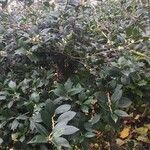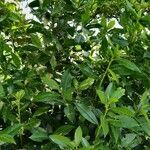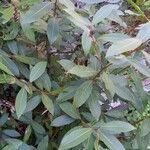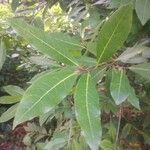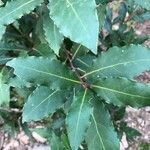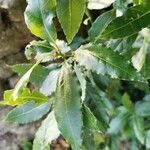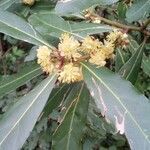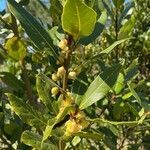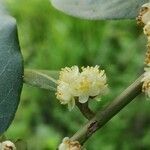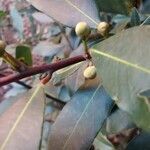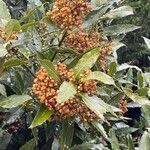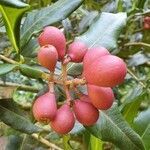Shrub or small tree to 12 m high (sometimes taller), evergreen, dioecious; bark blackish brown; branchlets puberulent to glabrous. Leaves alternate, aromatic when crushed; lamina ± oblong, oblong-lanceolate, narrowly oblong-elliptic or narrowly elliptic to lanceolate (some leaves on plant may be broadly elliptic-ovate), (4–) 5–13 cm long, (1.5–) 2–4 (–6.8) cm wide, cuneate at base, entire, sometimes undulate margin, acute to acuminate at apex, leathery, glabrous, upper surface slightly darker than lower; petiole 0.5–1.3 cm long, often purplish red. Inflorescence globose; involucral bracts suborbicular to ± broadly ovate, outer surface glabrous; flowers c. 6–10 mm diam., white to cream, pale yellow, pale yellow-green, light green or greenish white, sometimes pinkish-tinged, sweetly-scented. Perianth segments 4, broadly obovate to suborbicular; male flowers with c. 12 stamens in 3 whorls, the inner 2 whorls with glands, the outer whorl eglandular; female flowers with c. 4 staminodes. Fruit ovoid to ellipsoid, occasionally obloid-ellipsoid, c. 10–16 mm long, 10–14 mm wide, dark purplish to black, shiny, 1-seeded.
Capable of becoming a much branched evergreen up to 18 m. tall (mostly 7-12) it is usually kept low if used for providing leaves for flavouring; it can, however, be a handsome ornamental tree.. Leaves alternate, elliptic to oblong-lanceolate, 4-10 cm. long, 1.5-6 cm. wide, obtuse or acute at the apex, cuneate to rounded at the base, pinnately veined, glabrous, entire or faintly undulate, very aromatic.. Flowers unisexual, small, yellowish or yellow-green, in axillary umbel-like inflorescences supported by small involucres.. Fruits black, ovoid-ellipsoid, 1-1.8 cm. long, 0.8-1 cm. wide.
Large shrub or small tree to c. 7 m with many smooth trunks; vegetative parts glabrous or nearly so. Lvs aromatic; petioles 5-13 mm long, often purplish. Lamina 4-13 × 1.5-4.5 cm, narrow-elliptic or elliptic, shining above; base cuneate; apex acute, cuspidate or acuminate. Umbels in upper lf axils; peduncles c. 5 mm long, glabrous or puberulent. Involucral bracts c. 5 mm long, strongly imbricate, glabrous or puberulent. Pedicels ± puberulent. Perianth 3-4 mm long, cream or whitish. ♂ fls with 8-12 stamens. Berry 1.3-1.5 × 0.6-1.3 cm, narrow-to broad-ellipsoid, glossy black.
An evergreen tree which grows 10-20 m high. It spreads to 2.5-5 m wide. The bark is smooth and grey. The leaves are alternate. The leaves are oval and shiny and dark green. They are 3-6 cm long. The leaves have wavy edges and are leathery. The flowers are small and yellowish green. Male and female flowers are on separate plants. The fruit are one seeded dark berries. They are 1 cm long.
